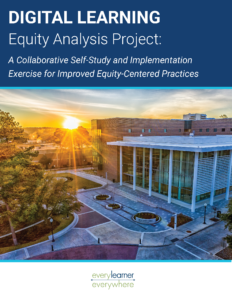After Dr. Sarah Straub, an Education Studies professor at Stephen F. Austin State University, attended the Every Learner Everywhere webinar, Digital Learning Praxis: Engendering Quality and Equity across the Learning Lifecycle, she was inspired. She wanted to see if she could apply what she learned, particularly by using a number of digital learning equity frameworks in the Caring for Students Playbook, one of the resources shared in the webinar.
However, Straub felt she needed time to engage more deeply with the concepts she was learning so she could apply them to her courses. So she recruited colleague Dr. Rachel Jumper, a professor in the School of Humanities, to collaborate with her on the digital learning equity frameworks. Each instructor selected one of her own online courses to review and utilized the frameworks in the Caring for Students Playbook to analyze and revise what they were doing.
Straub selected her undergraduate MLGE 4230 course for middle-level social studies methodologies, and Jumper chose her graduate-level introductory course in Human Sciences, HMSC 5300. Straub and Jumper describe their interpretation and application of the guidelines in the Caring for Students Playbook in a report titled Digital Learning Equity Analysis Project: A Collaborative Self-Study and Implementation Exercise for Improved Equity-Centered Practices.
Reducing cognitive load
 One of the first goals of the revisions the co-authors made to their courses was reducing their students’ cognitive load, a concept that explains how the human brain processes and manages information, suggesting that there is a limit to the amount of information a person can effectively process in their working memory at any given time. As described in the Caring for Students Playbook, cognitive load can be reduced by organizing course sites in easy to navigate formats, helping make connections to students’ lives to see how all of the pieces of the course fit together, breaking content into smaller groups of information, and reinforcing new information through application or quizzes.
One of the first goals of the revisions the co-authors made to their courses was reducing their students’ cognitive load, a concept that explains how the human brain processes and manages information, suggesting that there is a limit to the amount of information a person can effectively process in their working memory at any given time. As described in the Caring for Students Playbook, cognitive load can be reduced by organizing course sites in easy to navigate formats, helping make connections to students’ lives to see how all of the pieces of the course fit together, breaking content into smaller groups of information, and reinforcing new information through application or quizzes.
Jumper says her syllabus became more “humanized” after implementing these changes. “It’s easy to throw something on a syllabus and tell the students to do it,” she says. “I started doing more instructional videos that told the students ‘Here is what I’m looking for,’ and that added a lot to my class. Too often in online classes there are just words the students have to interpret and decipher to figure out what the instructor wants. This took the work off of them.”
Equity-centered design practices
Straub’s training included equity-centered design, which the co-authors describe in their report as “the practice of purposefully involving minoritized communities throughout a design process with the goal of allowing their voices to directly affect how the solution will address the inequity at hand.”
One issue influencing equity in Straub and Jumper’s digital classrooms was their university’s location in a rural area, leading to differences in reliable internet access. Their report emphasizes that some online platforms may be inaccessible to students with limited access to technology, so teachers need to be aware of the potential biases in digital learning platforms and actively work to overcome them.
Additionally, Straub and Jumper also began asking students more questions to understand their educational journeys so they could tailor their teaching and learning experience.
Straub says, “Students would say things like, ‘I’m a single mother of four and I do my work in the evenings,’ or ‘I work the night shift so I do my schoolwork on the weekends,’ and that allowed us to group the students together based on their similar schedules so that collaboration was easier.”
Pedagogy of care
The pedagogy of care is an approach to online teaching that emphasizes compassion, empathy, and support for students in online learning spaces. This pedagogy promotes a student-centered approach to teaching that prioritizes the well-being of the learner. Pedagogy of care recognizes that learners have different needs, experiences and backgrounds, and it is essential to create an environment that fosters a sense of community, trust and respect.
One practice she immediately implemented was a “Getting to Know You” quiz to learn more about what was going on in students’ lives. Using that, she would put important dates on her calendar to remind her to ask about a surgery or a significant celebration. “Oftentimes, after I did this, a student would reply to tell me it made their day and they’ve never had a professor reach out like this.”
Straub also learned in the Caring for Students Playbook that something as simple as highlighting information on the syllabus about student support services on campus made a huge difference in showing the students what the professors valued. “When the support services come after punitive practices like late work policies, it doesn’t really show that we are concerned with their well-being,” Straub says.
One adaptation Jumper made was to have more flexibility in her office hours to cater to her students, most of whom are non-traditional learners. “I always have office hours, but students don’t always come, so to create that connection I make myself more available. I realized I was giving hours on my time, not theirs,” she says.
Related reading — Practical Ways Faculty Can Normalize Student Support Services
Rekindling
Revamping their syllabi was just one part of redesigning their courses, which took nearly the entire summer for each of them, but the work was meaningful and impactful for their students. In the conclusion to their report, they write that this activity “demonstrates the effectiveness of utilizing a structured protocol to analyze online courses for alignment to data tools and potential biases.”
“In my end-of-semester surveys, students said they felt like they had a relationship with me and an opportunity to speak to me about their work one-on-one in conferences,” says Straub. “The online classroom felt like a safer place. They also really liked that in an online world there are still collaborative assignments with peers.”
The two instructors plan to continue working together to dig deeper into their classes and incorporate additional strategies from the Caring for Students Playbook. They also hope in the future to start a cohort professional development program at Stephen F. Austin State University for colleagues interested in digital learning equity frameworks.
“Going through my courses like this really rekindled for me why I do what I do,” Jumper says. “Too often we continue to teach the same way, but that way isn’t always the best way for the students.”
Download Digital Learning Equity Analysis Project: A Collaborative Self-Study and Implementation Exercise for Improved Equity-Centered Practices

